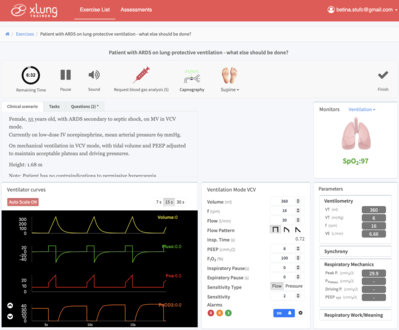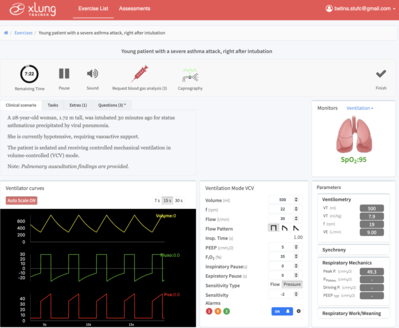🫁🔍 New Xlung Trainer Cases: ARDS Protective Ventilation and Severe Asthma Management
By: BETINA SANTOS TOMAZ, FISIOTERAPEUTA - 10/07/2025 15:57
Two new clinical cases are now available on the Xlung Trainer for you to test your knowledge and strengthen your decision-making skills in mechanical ventilation, based on realistic and challenging ICU scenarios 👇🏼
🫁 1️⃣ ARDS patient under protective ventilation — what else can be done?
📌 Clinical case:
A 55-year-old woman with ARDS secondary to septic shock, receiving low-dose norepinephrine (MAP: 69 mmHg).
Scenario:
The patient is on volume-controlled ventilation (VCV), with tidal volume and PEEP adjusted to maintain plateau pressure and driving pressure within recommended protective limits.
Height: 1.68 m.
No contraindications for permissive hypercapnia.
In this exercise, you will:
✅ Classify the severity of ARDS according to the current criteria.
✅ Identify the driving pressure before any parameter adjustments.
✅Implement evidence-based ventilatory strategies to optimize mechanical ventilation.
✅Explore additional simulator features such as prone positioning and capnography, enhancing your practical experience.
🤓An excellent opportunity to deepen your clinical reasoning and consolidate the principles of lung-protective ventilation in ARDS.
🔗 Access here: Patient with ARDS on lung-protective ventilation - what else should be done?
🫁 2️⃣ Young patient with a severe asthma attack — right after intubation
📌 Clinical case:
A 28-year-old woman (height: 1.72 m) was intubated 30 minutes ago due to status asthmaticus triggered by viral pneumonia.
She is hypotensive, requires vasoactive support, is sedated, and receiving VCV.
In this exercise, you will:
✅ Evaluate the respiratory mechanics and analyze the available ventilatory data.
✅Adjust the ventilator settings according to evidence-based recommendations and the specific characteristics of this case.
✅ Apply strategies to reduce dynamic hyperinflation and optimize patient safety.
🔗 Access here: Young patient with a severe asthma attack, right after intubation
📵 Note: this exercise is not suitable for mobile devices. For the best experience, use a laptop or desktop computer.
💬 Join the discussion on the Xlung Forum!
Share your clinical reasoning, compare your approach with colleagues, and discuss the physiological principles behind your decisions.
Each scenario was carefully designed to strengthen your critical thinking and mastery of mechanical ventilation.
To add an answer on this topic and read the replies...
You must have a valid and active xlung subscription
If you are already a subscriber, please Login at the top of the page, or subscribe now

